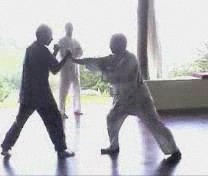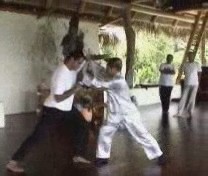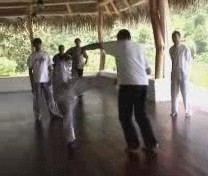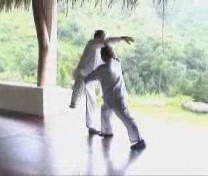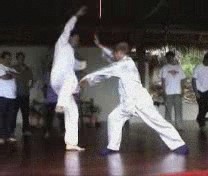COMBAT APPLICATIONS OF WAHNAM TAIJIQUAN

Surprisingly many Taijiquan practitioners do not realize that Taijiquan is a very effective martial art. Obviously merely practicing solo Taijiquan forms alone would not enable the practitioners to be combat efficient.
A systematic combat training programme is necessary. In Wahnam Taijiquan, our sparring methodology includes the following.
Practitioners must first be able to perform Taijiquan patterns reasonably well. Next they develop internal force and practice footwork. Then they proceed to "Pushing Hands" and "Striking Hands", and eventually they proceed to combat sequences and free sparring.
Wahnam Taijiquan practitioners are free from injury in their sparring, and there is much laughter and fun in their combat training -- two points that are of particular significance today when classmates often hurt themselves in their friendly sparring.
As part of our effort to share our knowledge and experience with those who believe that Taijiquan can be effectively used for combat, and that sparring practice can be fun, without the necessity of sustaining injury, the following video clips revealing our sparring methodology are released. These video clips were taken impromptu on the spot — without prior preparation and without editing. They showed our training sessions as they were, including the mistakes we made.
Although it may not be so obvious from the video clips, observant viewers may notice another point we have often mentioned, i.e. with proper training, especially in breath control, one can be relaxed and not tired after hours of sparring. Jeffrey explains the breathing methods and control we use in our Taijiquan (as well as Shaolin Kungfu) in a series of articles. Here is one of these articles.
One should bear in mind that besides techniques, other variables like experience and skills are very important in combat. Hence, even if he knows the techniques well, and they are indeed excellent techniques against a Boxing or a Muay Thai opponent, he can still be beaten by an experienced Boxer or Muay Thai fighter.
Understanding how an opponent fights is an essential aspect in combat efficiency. Hence, in order to fight effectively against a Boxer, participants first imitate how a Boxer himself fights. Then they apply the Taijiquan technique known as “Lazy to Roll up Sleeves” to keep a Boxer at bay. In Shaolin Kungfu this pattern is known as “Fierce Dragon Across Stream”. Both names have significant connotation.
In Chinese idiom, “Fierce Dragon Across Stream” is often used to describe a capable fighter. A punch, like a strike from a Boxer, is characterized as a Tiger. It is appropriate to have a stream-crossing Dragon to intercept the Tiger. If the interception is successful, there is no need to progress to fighting. Hence, “Lazy to Roll up Sleeves” implies that it is unnecessary to roll up one's sleeves to fight.
After being able to keep a Boxer at bay using “Lazy to Roll up Sleeves” as well as developing the skill of observing the opponent calmly, the next step is to counter attack as he strikes. As the Boxer throws a jab, often regardless of whether the jab is a real or a feign attack, deflect his jab with one hand and strike his chest with the other, employing the Taijiquan pattern “Jade Girl Threads Shuttle” and implementing the principle of “starting later but arriving earlier”.
Be careful that the opponent may throw another jab with the other hand, especially if the first jab is a feign move, in which case change the attacking hand into a deflecting hand, and the deflecting hand into a palm strike into his chest. The same technique but used by Shaolin exponents is shown in another video clip. Back with internal force, a palm strike on the solar plexus can cause serious injury or even kill. So take care not to hurt your partner in your training.
The size of the video clip is 2.85 mb.
An excellent counter against a Boxer, almost irrespective of how he attacks, is a side kick. As the Boxer launches forward to execute his jabs or any attack, lean back sideway and execute a side kick at his ribs, abdomen or any exposed part.
A Boxer is not trained how to defend against kicks (as kicks are not permitted in Boxing rules), but in case he grabs your kicking leg, throw your body forward and strike his head or shoulder with "Immortal Pounds Mortar".
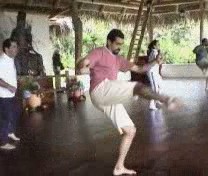 Understanding the Combat Behaviour of a Muay Thai Fighter
Understanding the Combat Behaviour of a Muay Thai Fighter
The great strategist of ancient China, Sun Tzu, advises that if you know yourself and know your opponent, you can win a hundred victories over a hundred battles. Hence, before we practice combat application against Muay Thai, or Siamese Boxing, we need to understand the typical combat behaviour a Muay Thai fighter. The following are important points.
A Muay Thai fighter is extremely fast, powerful and tricky, he almost always attacks continuously mixing feign and real moves, and he frequently uses elbow strikes, knee jabs and sweeping kicks. Unlike a Boxer who usually poises with one foot in front of the other, a Muay Thai fighter usually faces his opponent face-on, giving his opponent little indication which leg he will initiate his kicks.
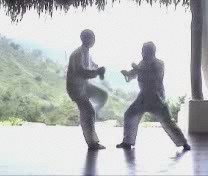 Avoiding the Opponent's Strength and Attacking his Weakness
Avoiding the Opponent's Strength and Attacking his Weakness
An important principle in combat is to avoid the opponent's strength and attack his weakness. After having some knowledge of the typical combat behavoiur of a Muay Thai fighter, we then examine what strong points in Taijiquan we can use against Muay Thai weaknesses.
First Sifu Wong shows what a combatant should not do when facing the attacks of a Muay Thai fighter because doing so would enable the opponent to maximize his strong points. Then Sifu Wong shows how one can use Taijiquan skills and techniques to attack Muay Thai weaknesses, which is using the versatility of the Bow-Arrow Stance and the Taijiquan pattern "Green Dragon Shoots Pearl" to avoid Muay Thai kicks then strike the soft spot of the attacker's leg.
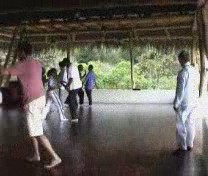 Applying Taijiquan Techniques against Muay Thai Attacks
Applying Taijiquan Techniques against Muay Thai Attacks
This impromptu video clip shows participants at the regional Taijiquan course in Costa Rica in February 2005 applying Taijiquan techniques against Muay Thai attacks. Understandably their movements are not smooth yet. Not only they do not have experience in Muay Thai, many of them are new to Taijiquan.
But if they practice these techniques for a year, they would be more combat efficient against Muay Thai fighters than other martial artists who free spar haphazardly for three years or Taiji practitioners who merely practice external forms for twenty years. More importantly, they do not hurt themselves in the sparring, but find the training full of fun.
 Using the Opponent's Tactics against Himself
Using the Opponent's Tactics against Himself
A Muay Thai fighter, or a Kickboxer, seldom makes an isolated attack. His attacks usually come continuously in a series. Often he starts with a frontal leg tap, frequently throwing his body forward in this initial move because it enables him to close in with a sweeping kick followed by a knee jab. A good counter against the frontal leg tap is “Immortal Pounds Mortar” (called “Lohan Strikes Drum” in Shaolin Kungfu), breaking the opponent's leg with one strike.
But a skilful Muay Thai fighter may use this as a feign move, then jumps in with a sweeping kick. A well trained Taijiquan exponent can play along with the opponent's tactic, then turns it against himself. Lean back onto a Low Stance to avoid the frontal leg tap, then move your body forward to intercept his next move, striking the soft spot of his thigh or knee with one palm, and striking his chest with your other palm, using the pattern “Green Dragon Shoots Pearl” which will frustrate his following intended move.
Take note of the following two important points. Your left palm is a strike against his thigh or knee, and not a block at his shin. Blocking his powerful sweeping kick may result in your palm or wrist being fractured. Your right hand should be fully extended to keep him at arm's length, otherwise he may be able to strike you with his hands. If he attempts to strike you, sink back to avoid, then move forward to strike him.
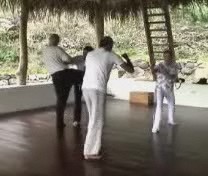 Application of Internal Force in Palm Strike
Application of Internal Force in Palm Strike
Sifu Wong advises course participants to be very careful when applying the palm strike on their sparring partners (or even actual opponents) in this counter. Because of their internal force training, it is not uncommon that they can be more powerful than they themselves realize. With internal force, a palm strike on a person's solar plexus can be disastrous. It can distort the person's energy field without leaving any physical mark outside.
Sifu Wong gives the example of Ronan breaking the bottom brick of two bricks piled one on top of the other. Even a brick protected by another brick can be broken, one can imagine what damage can be done to an internal organ struck with internal force. Hence, we can merely push our sparring partner (or opponent) away instead of striking him.
Sifu Wong explains that when pulling down an opponent's head while attacking him with knee jabs, a Muay Thai fighter usually holds only one side of the opponent's neck, instead of both sides. This is because gripping the neck with fingers is not allowed in Muay Thai.
A good counter is a modification of "Green Dragon Shoots Pearl". Instead of striking the opponent's chest with your right palm, while intercepting his knee strike with your left palm, here you use your right forearm to strike across his both arms to dislodge his hold on your neck.
This pattern is called “Scissors Hands” in Shaolin Kungfu. Immediately follow up with a kick at his groin with your knee or foot if the opponent is near, or with a side-kick if he has been bounced off a short distance away.
Click here to enter>/a>
The kind of force used to dislodge the opponent's hold on the head as well as to intercept his knee jabs is known in kungfu terms as "cold force", which is a particular way of exploding force, or "fa-jing". The force is released suddenly without tensing any muscles.
It is not pushing the opponent's arms away using tensed muscles. The opponent's both arms must be bounced away a safe distance from the face. Hence, the application by Deigo on Piti, and the application by Andrew on Dr Martha shown at the start of the video clip, are incorrect because Piti's right hand slips down on Deigo's head, and Dr Martha's right hand brushes against Andrew's face.
In a real fight this could be serious trouble. Their mistakes in this training session, therefore, are a very important lesson for us. An effective way to develop "fa-jing" using "cold force" is to practice "Single Whip" as shown by Sifu Wong at the end of the video clip.
In Taijiquan training, “Pushing Hands” is meant to develop combat skills, and “Striking Hands” is meant to develop combat techniques. This video clip shows Sifu Wong and Sifu Rama demonstrates the technique of the vertical punch and its defence during a Taijiquan class at the Shaolin Wahnam Centre in Costa Rica in February 2005.
Many people, including many Taiji students, do not realize that genuine, traditional Taijiquan is very effective for combat, besides for health and spiritual cultivation. “Pushing Hands” and then “Striking Hands” are methodical approaches to free sparring and real fighting in Taijiquan combat training. In Shaolin Wahnam, after having familiarized ourselves with using appropriate techniques to meet various combat situations, we employ combat sequences in our “Striking Hands” training.
This video taken in 2002 during a Special Taijiquan Course in Malaysia shows Javier and Jeffrey, who are Wahnam Taijiquan instructors from Spain and Australia respectively, demonstrating the various combat sequences in Wahnam Taijiquan. In this first sequence, Jeffrey attacks with two palm thrusts and a "Punch Below Sleeves".
Short notes and still pictures of this combat sequence can be found
here
In this second Combat Sequence, Jeffrey attacks with a palm thrust to the opponent's throat. Javier deflects the attack and counters with a left palm thrust. Jeffrey deflects the attack and counters with a middle punch. Javier “sinks” Jeffrey both arms and is about to grip them, but Jeffrey neutralizes with a circular movement, followed immediately with a push using the Taijiquan pattern "Fierce Tiger Pushes Mountain", simultaneously moving his back left leg forward.
All the movements in these combat sequences are pre-arranged. Will students be able to fight if they train in pre-arranged sequences? The purpose here is not to fight freely yet, but to develop suitable skills and techniques which prepare them for free sparring and actual fighting later on.
Short notes and still pictures of this combat sequence can be found
here.
“Da Shou” or “Striking Hands” is an effective way to train combat efficiency in Taijiquan. This video clip, taken soon after their Special Taijiquan Course in Malaysia in 2002, shows Jeffrey and Javier practicing the third sequence, “White Snake Shoots Venom” in our Wahnam Taijiquan combat application series.
Jeffrey attacks with three consecutive palm thrusts at Javier's throat, while covering Javier's counter attacks at the same time. Notice that Javier uses first his right hand, next his left hand, and then his right hand to ward off Jeffrey's attack, using both the “peng” and the “lu” techniques while counter-attacking, and employing the famous Taijiquan tactic of ”lian xiao dai da” or “defence cum attack”.
It is important that all the movements should be performed in chi flow without muscular tension. When assailants attack them in similar ways, trained exponents would be able to apply these Taijiquan skills and techniques to overcome the combat situations.
Short notes and still pictures of this combat sequence can be found here
Jeffrey initiates with “White Snake Shoots Venom”. After brushing away Jeffrey's palm thrust, Javier responds with “Green Dragon Shoots Pearl”, changing from right Bow-Arrow to left Bow-Arrow to press into the opponent.
Jeffrey has to sink back low to neutralize the pressing attack, then presses back with “peng” or “Immortal Wave Sleeves”. Javier returns to his right Bow-Arrow and strikes with “Lazy to roll up Sleeves”.
Besides getting the techniques right, students must ensure that they are relaxed and their movements are fluid yet powerful, not staccato and muscular, otherwise it would not be Taijiquan. Such combat sequence training enables students to develop appropriate Taijiquan skills and techniques so that they can spontaneously apply them in actual combat situations.
Short notes and still pictures of this combat sequence can be found here
This is a variation of Sequence 4 Instead of responding with "Immortal Waves Sleeves", Jeffrey uses "White Crane Flaps Wings", which is a deadly kicking technique. He also uses the tactic "defence cum counter" to counter-attack Javier's "Green Dragon Shoots Pearl".
Irrespective of whether his counter-attacks are strikes, kicks, felling or grips, the Taijiquan exponent must maintain his fluidity of movement, energy flow and breath control. In this way not only he can be fast and uses internal force, he can spar for a long time without feeling tired. Needless to say, the Taijiquan skills and techniques shown here are effective against not only opponents using Taijiquan.
Once you are well trained, you can use these Taijiqian skills and techniques against any opponents using any martial arts or who fight without using any special styles. If a Judoka or a Wrestler attempts to grip you to effect a throw, for example, you may use “White Crane Flaps Wings” as shown here to kick his groin, or “Lazy to Roll up Sleeves” as in Sequence 4 to strike his face or chest.
Short notes and still pictures of this combat sequence can be found here
Many students wonder how kungfu, including Taijiquan, can be used for combat! This is ironical and reflects the disgraceful situation that kungfu has degenerated into. If kungfu is a martial art (and it is) it is meant for combat. If they cannot apply kungfu for combat, it means they have not learnt genuine kungfu or they may have learnt it incorrectly.
This series of video clips is aimed at helping them to better understand how Taijiquan can be used for combat. Here, Jeffrey attacks with a palm strike using the pattern “Lazy to Roll up Sleeves”. It could also be a Boxer's jab or a Karateka's punch, except that exponents of other martial systems normally would not pay as much attention to such factors like stances, balance and coverage as Jeffrey shows here.
Javier responds with “Punch Below Sleeves”, defending cum counter-attacking. Jeffrey brushes away the punch and replies with a hanging fist. Javier moves aside and executes a side-kick, this time employing the tactic of “no defence direct counter”. Jeffrey avoids the kick using “Low Stance Single Whip”, and as soon as the kick is spent, he moves forward with a palm strike, which Javier wards off.
Short notes and still pictures of this combat sequence can be found here
Taijiquan is a complete art. This means a skillful exponent can use Taijiquan to handle any forms of attack, without having to borrow techniques from other martial systems. In other words, there is no need for a Taijiquan exponent to cross-train.
This video clip illustrates how you can apply Taijiquan techniques to counter a thrust kick as well as how to get out if your kicking leg been grasped by an opponent. Jeffrey initiates the attack with two middle level punches, then executes a thrust kick.
Javier dodges and grips the attacking leg, using the “lu” technique or the pattern “Carrying the Cosmos”. Following the attacker's momentum, Jeffrey moves forward with a hanging fist. Javier has to release the leg to defend against the attack on his head, which could be fatal.
Short notes and still pictures of this combat sequence can be found here
Jeffrey initiates with a palm strike. Javier wards off the palm strike and counters with a side kick. Jeffrey avoids the kick with the pattern “Low Stance Single Whip”. When you are skillful, you can use this Taijiquan pattern, “Low Stance Single Whip”, against almost any kicks!
Immediately after the side kick, Javier moves forward with a knee strike. Jeffrey counters with “Move, Ward off and Punch” or “Ban Lan Chui” in Chinese. When you can apply these techniques skillfully, you can use them against opponents of other martial systems.
For example, if a Western Boxer attacks you with jabs, you can responds with a side kick, like what Javier does. If a Muay Thai fighter gives you a frontal kick, followed by a knee strike, you can respond with “Low Stance SingleWhip” and “Ban Lan Chui”, as demonstrated by Jeffrey.
Short notes and still pictures of this combat sequence can be found here
After warding off Jeffrey's attack, Javier moves in to throw Jeffrey using the pattern "Carry Tiger Back to Mountain". Jeffrey responds with "Black Bear Sinks Hips". If Javier is not well trained, he would find himself thrown on the ground instead! It would not be easy for the uninitiated to understand how this could happen.
To neutralize Jeffrey's throw (which may not be obvious to many people), Javier also uses "Black Bear Sinks Hips". Jeffrey then attacks with a knee strike, using the Taijiquan pattern "Golden Cockerel Stands Solitarily". Javier responds with "Move, Ward Off and Punch", as in Sequence 8. The Taijiquan techniques shown in this video clip are very useful against opponents using Judo and Muay Thai.
Short notes and still pictures of this combat sequence can be found here
As a complete martial art, Taijiquan incorporates all the four categories of attack, namely striking, kicking, felling techniques and grips, and the counters against all these different attacks. In other words, if you are well trained in Taijiquan combat, you can effectively defend yourself against opponents using any martial styles or free fighting.
Many martial arts or sports today do not have this comprehensive feature. A Taekwondo exponent, for example, may not know how to release his leg if it is caught by his opponent. A Kickboxer may not know how to release his arm if his opponent caught it. They do not have the appropriate counters because such attacks are not allowed in their arts.
In this video clip, as Jeffrey attacks, Javier follows Jeffrey's momentum, grips his arm and pulls him to fall forward. Jeffrey relaxes his arm, follows Javier's momentum and strikes Javier with his shoulder. Here are two examples of the famous Taijiquan tactic of “using the opponent's force against himself”. Javier releases his grip and strikes Jeffrey's face, using the tactic of “long against short”.
Short notes and still pictures of this combat sequence can be found here
What would you do if your opponent grips your hand, pulls you forward and simultaneously strikes you with his other hand? If your stance is not good, you will be falling onto his on-coming attack. An effective counter is shown in this video clip, using the tactic of “retreating while moving forward”.
As Jeffrey pulls Javier forward with his right hand while his left hand strikes Javier's eyes or throat with “White Snake Shoots Venom”, Javier moves glides his right leg forward if necessary to neutralize the pulling momentum, and simultaneously slants his body backward to avoid the palm thrust. Immediately Javier counters with “Green Dragon Shoots Pearl”.
Jeffrey moves to a side and counter-strikes with “Jade Girl Threads Shuttle”, employing the tactic of “defence cum counter”. Javier responds with a left low punch, and Jeffrey counters with a right low punch. Javier grips Jeffrey attacking arm with his two hands (similarly to the qin-na technique shown in the previous video). Jeffrey releases the grip with “Cloud Hands” and strike with “Lazy to Roll up Sleeves”.
Short notes and still pictures of this combat sequence can be found here
What would you do if a wrestler or grappler twists your arm to your back and locks it. A good counter is to use the Taijiquan pattern “Carry Tiger Back to Mountain”. Using the opponent's force against himself, you will not only release his grip but also throw him onto the ground, as illustrated in this video clip.
But Jeffrey is not thrown to the ground by Javier because Jeffrey neutralizes Javier's counter attack with the pattern “Golden Cockerel Stands Solitarily”. Javier retreats his front leg to avoid the knee strike, and counter attacks with “White Snake Shoots Venom” to Jeffrey's eyes. Jeffrey neutralizes by warding off the attack.
This series of video clips show the application of basic Taijiquan skills and techniques in implementing all the four categories of attacks, and how to counter them. Indeed, all these four categroies of attack and defence are found in this series itself. When you have been well trained in these basic skills and techniques, you can apply Taijiquan against not only opponents who use Taijiquan or other kungfu moves but also opponents who use other martial systems or who fight in unorthodox ways.
Short notes and still pictures of this combat sequence can be found here.
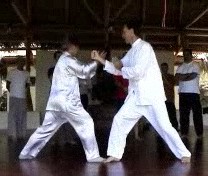 Taijiquan Striking Hands -- Vertical Punch
Taijiquan Striking Hands -- Vertical Punch
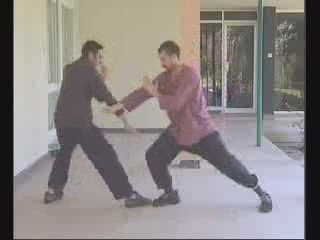 Taijiquan Combat Sequence 1 - Immortal Waves Sleeves
Taijiquan Combat Sequence 1 - Immortal Waves Sleeves
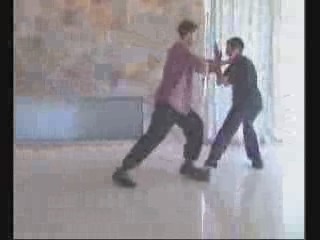 Taijiquan Combat Sequence 2 -- Punch Below Sleeves
Taijiquan Combat Sequence 2 -- Punch Below Sleeves
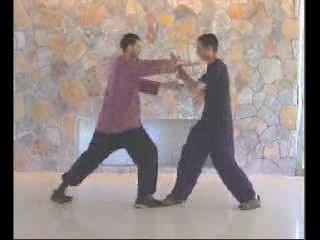 Taijiquan Combat Sequence 3 -- White Snake Shoots Venom
Taijiquan Combat Sequence 3 -- White Snake Shoots Venom
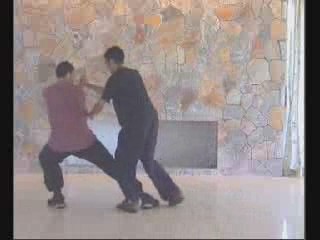 Taijiquan Combat Sequence 4 — Golden Dragon Shoots Pearl
Taijiquan Combat Sequence 4 — Golden Dragon Shoots Pearl
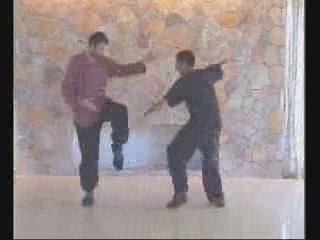 Taijiquan Combat Sequence 5 — White Crane Flaps Wings
Taijiquan Combat Sequence 5 — White Crane Flaps Wings
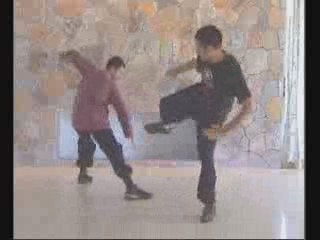 Taijiquan Combat Sequence 6 — Low Stance Single Whip
Taijiquan Combat Sequence 6 — Low Stance Single Whip
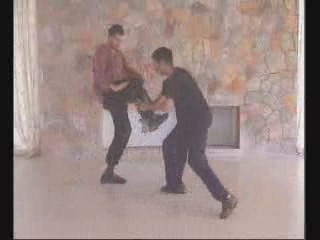 Taijiquan Combat Sequence 7 — Thrust Kick
Taijiquan Combat Sequence 7 — Thrust Kick
![]() Taijiquan Combat Sequence 8 — Move, Ward off and Punch
Taijiquan Combat Sequence 8 — Move, Ward off and Punch
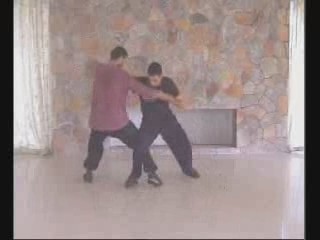 Taijiquan Combat Sequence 9 — Black Bear Sinks Hips
Taijiquan Combat Sequence 9 — Black Bear Sinks Hips
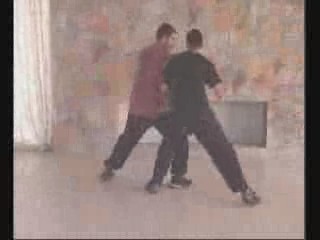 Taijiquan Combat Sequence 10 — Shoulder Strike
Taijiquan Combat Sequence 10 — Shoulder Strike
 Taijiquan Combat Sequence 11 — Cloud Hands
Taijiquan Combat Sequence 11 — Cloud Hands
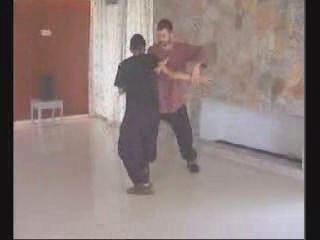 Taijiquan Combat Sequence 12 — Carry Tiger Back to Mountain
Taijiquan Combat Sequence 12 — Carry Tiger Back to Mountain
LINKS
Courses and Classes

